When Clayton Hergert of ATX Precision launched his first Precision Rifle I course, TTAG writer Tyler Kee was first in line. His excellent review of the infant course is well worth the read. Going on a year later, and with a few iterations of the course under Clayton’s belt, I was interested in taking the course myself.
I’m a bit different of a shooter than Tyler. I’ve been shooting a couple decades longer, and my old and broken bones don’t enjoy lying still in the prone anymore. They really don’t like getting into and out of the prone. I’ve also had a career in the Army, and I’ve successfully engaged targets out to 800 meters during combat on multiple occasions.
I’ve had some previous professional long range instruction, both in and out of the military. In short, I’ve had a few different experiences behind the gun, and a few different needs from the course than most beginners.

Clayton and I have a few friends in common, all which spoke highly of him. This fact, despite Clayton being both a former Navy SEAL and an officer, means that he must be one hell of a dude, disregarding his obviously misguided military career choices.
Just like he did for Tyler’s course, Clayton emailed out a course prep email that let everyone know what was the course was going to cover, materials needed, and asked what our goals were for the course. He was also available by phone and email, which I used pretty heavily prior to the course.
Although I would appreciate the entire course, I wanted to focus on shooting from positions other than the prone. First, I’ve broken some vertebrae and I’m missing a disk in my lower back thanks to 1,000lbs of HME, so the prone just plain ol’ hurts like hell. Beyond that, I find very little use for it in most hunting applications.
There always seem to be either vegetation or terrain in the way when lying down, even off a high bipod or backpack. Instead, in order to get above the obstructions, I find myself shooting from the kneel, or rested on a branch, a fence post, or the hood of a vehicle. I told Clayton I’d like to focus there instead of the prone.
Shooting at a still target from the kneel at 300 yards isn’t much of a challenge. In the real world, with wind, an animal free to walk around, varying shot angles and not much time, guaranteeing a 300 yard shot into a deer’s vitals from the kneel is iffy for most hunters. It certainly is for me. I wanted to focus on all the different methods I could employ to get reliable hits on those above-the-grassline shots.
Clayton assured me that he could accommodate my request, all the way out past the 800 yard line. I was stoked.
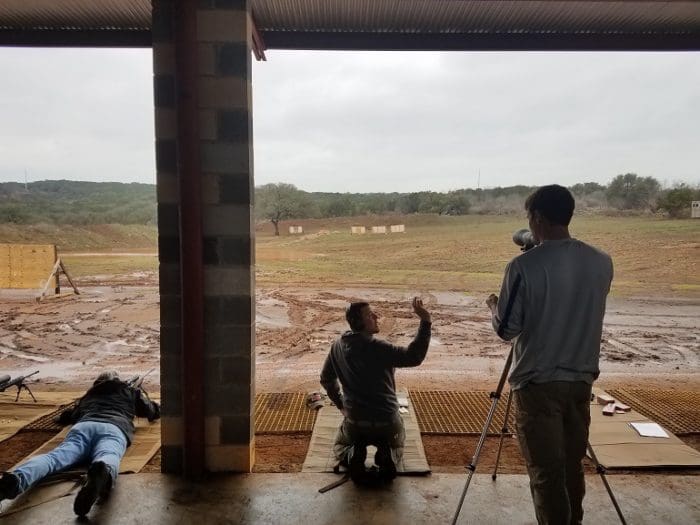
The first day began with a quick introduction inside the classroom, followed by an immediate 100 yard zero right next door. Just like every professional instructor with a military background I’ve ever taken a shooting course from, Clayton recommended a 100 yard zero for all for all of the ranges and applications we would be shooting over the next two days.
My class had 7 shooters present, and Clayton as well as another Navy SEAL, Nick Klein, as an assistant instructor. On the zero line, Clayton talked with folks one on one if they were having any issues with breathing, trigger control, whatever it took for them to get a solid zero. It’s also the first place he emphasized proper shooting position and the three primary fundamentals for long range shooting: stability, consistency, and observation. We would be putting those fundamentals to the test repeatedly over the next two days.
Fortunately, everyone zeroed very quickly and we drove out to the 400 yard line to get started on the shooting portion of the course. Right away, you could tell who was applying the lesson on body position and who wasn’t.
Unlike many courses I’ve been to, Clayton uses relatively small targets. I see a whole lot of people clapping happy that they “hit the target” at 1,000 yards. Then I see that target is somewhere between 19″ and 36″ across. When you find me any game animal with a 36″ vital zone, please, drop me a line. That target size just doesn’t teach you much, and it’s practical. Clayton keeps most of his targets closer to the 1MOA size, and that includes the movers. 6″ plate at 500 yards, moving at 5MPH, and the target is only up for 3 seconds? You’ve got a little challenge on your hands. The largest target is 10″, and Clayton likes to reserve that one for the folks that only have a max power 10X scope, out to 1,000 yards.
At this range, we were all focusing on the 6” and 8” targets. All of the rifles present, from the most expensive PRS style rifles in 6.5 Creedmoor to the bone stock Remington 700BDL in .30-06 were capable of shooting this target at that range. But many people were not.
Even at this relatively short range, you could see the effect of being out of line with the gun, or the big effect that applying torque to the grip would have on where the round landed.
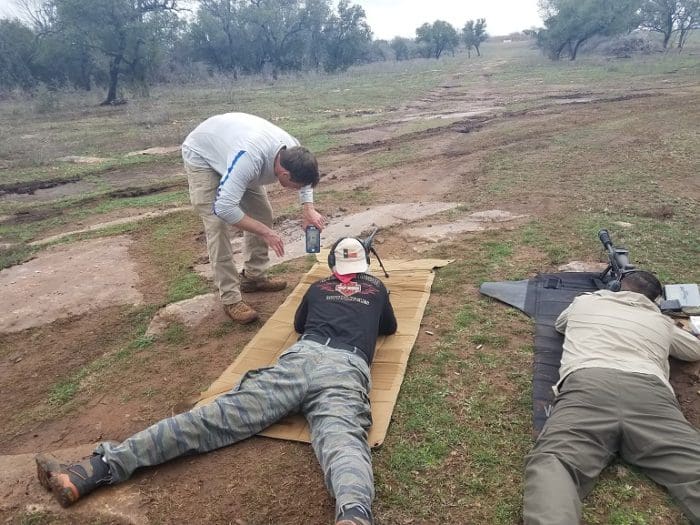
In short, the rifle needs to be in line with the body, from the tip of the barrel, down the inside of the firing arm, through the shoulder, straight down a relaxed and unloaded spine, and through the edge of the groin on the firing side. The feet should be equidistant and spread. The shoulders and head should be relaxed, as should the grip.
Sometimes it feels like you are in line, when you really aren’t. Clayton would stand behind each of us and take photos of our position when we were out of line, to show us exactly what we were doing wrong. It was super helpful.
Clayton taught that you should be relaxed enough to close your eyes, take a breath, open them up, and still be exactly in the same place, looking through the glass.
Many of us, me included, tend to level out the rifle and get it on target by torqueing the grip and maintaining that pressure during the trigger squeeze. Of course, what actually happens is that the rifle then loses that torque when the firing pin strikes, and the muzzle does indeed have time to change its position prior to the bullet exiting the muzzle.

At short ranges, or on large targets, that works. At longer ranges, or at smaller targets, the results are disastrous. Like many folks, I help to combat this by putting my firing hand thumb to the side, not wrapped around the grip. I was still having an issue with using the pistol grip of the rifle to push the rifle level. Clayton showed a different grip, with the thumb to the side and the fingers curled so that only the tips of the fingers on the firing hand rested on the grip. I found this removed my ability to muscle the gun over, and was a great, repeatable way to get my hand firing hand on the weapon.
Of course, not being able to muscle the gun over meant that I had to line up the gun better on the initial approach. That’s when the second fundamental, consistency, kicked in.
Clayton encouraged everyone do get behind the gun the exact same way every time. Since I am a simple creature, I took that to the extreme, and went all the way to which foot came back first, which knee set down first, which part of my hand hit the ground first, how I held my feet prior to pushing forward on rifle, which part of the stock touched my shoulder first, etc… When I went home that first night, I walked through that exercise and wrote it down as a check list for several different positions. I was, and still am, surprised at the difference it made.
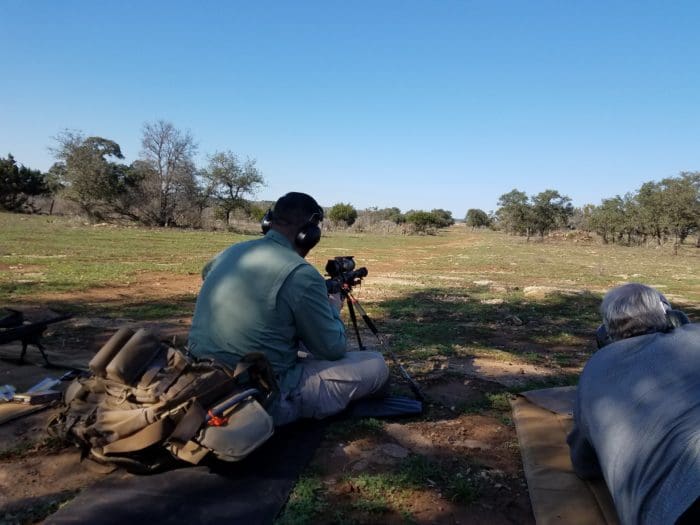
We broke up in spotter/shooter pairs. My partner was shooting a suppressed Ruger Precision Rifle in 6.5Creedmore with some great Vortex Razor glass. Despite some good groups on the zero line, he was having trouble with what was essentially a 2MOA target. Getting behind him, his body was obviously curved to the left. To him, it all felt in line, but from my position, his body position was obvious. Once that was corrected, the 8” targets were no trouble at all, even when we moved back to the 500 yard line.
The object lesson of the first round of shooting at intermediate distances was well learned. The fundamentals of stability, consistency, and observation were simple to remember, much harder to employ. But still absolutely vital, even at relatively short distances.

We then moved back into the classroom to learn a little about my inconstant nemesis, wind. Clayton gave a great discussion on the ways to estimate for wind, as well as a couple of different ways to calculate for correction. He broke this down to the Science and the Art section of wind calling. Ya’ll, the science is easy. I can do the math. But that art part is the bear that eats me every time.
Clayton gave us quite a few different methods for what to observe to give us better clues on the wind. In the end, the best way to correctly estimate the wind is to pay attention, and get lots of experience. There’s just no making up for the need to watch and call your wind with a Kestrel for validation, and good math. You have to put in the work. Heck.
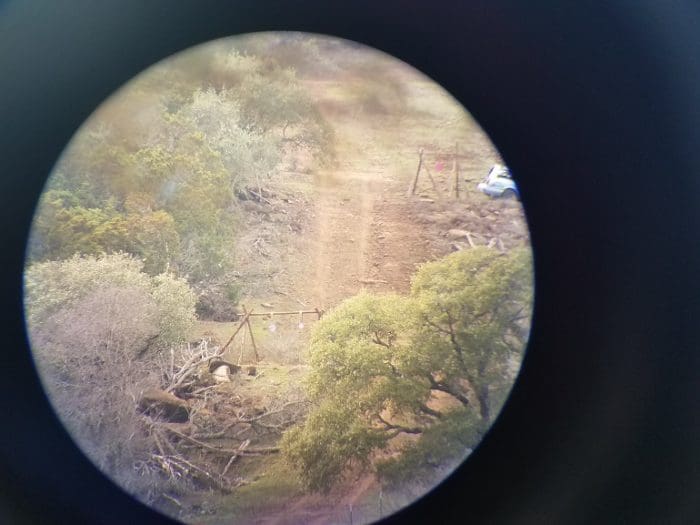
We put those observation skills to the test with the next section of shooting. Driving only a couple hundred yards, we set up perpendicular to a long ravine and down a fence line, where multiple targets were hanging from 400 out to 700 yards. This was actually the most challenging portion of the course for most folks. The goal was simple, find the closest target, shoot it, then move back, finding each one, until you’ve shot them all.
The natural terrain, plus a few optical illusions made that simple task much harder. There were two cross-winds on that range, and if you were shooting at the farther targets, they almost completely cancelled each other out. You had to learn that by either missing a lot, or paying careful attention to the vegetation throughout the range, all the way to the target, not just right in front of the target itself.
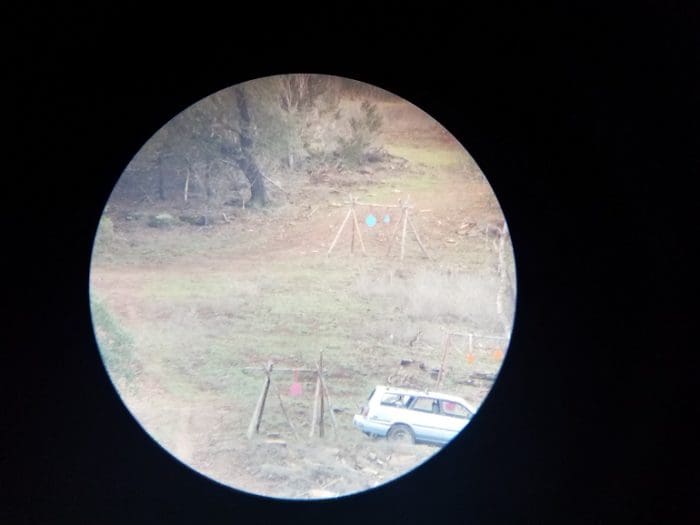
Clayton also set up targets of differing sizes at different ranges, giving the effect that two targets were next to each other, when in fact they were 100 yards apart. Again, the key was carefully observing the terrain all the way up to the target. Beyond that, not all targets were out in the open, challenging you to correctly estimate their distance and the windage while they were obscured by shadow or vegetation.
The role of the spotter was also brought up, as well as how to spot the trace of the round and the splash. The key to seeing the trace of the round as it flies through the air is to not focus on the target, but just in front of it. Like that, even at distances as close as 400 yards, I could tell if the round would strike the target or miss well before seeing the ballistic end result. When it all worked right, the cadence of sound was great:
BANG, Call “hit”, (see it hit)…..hear the ring of the steel, hear the laughs of joy.
There is just something about that little sound from far away, especially after you’ve had to wait a few seconds since you saw the round strike the target. It’s highly addictive.
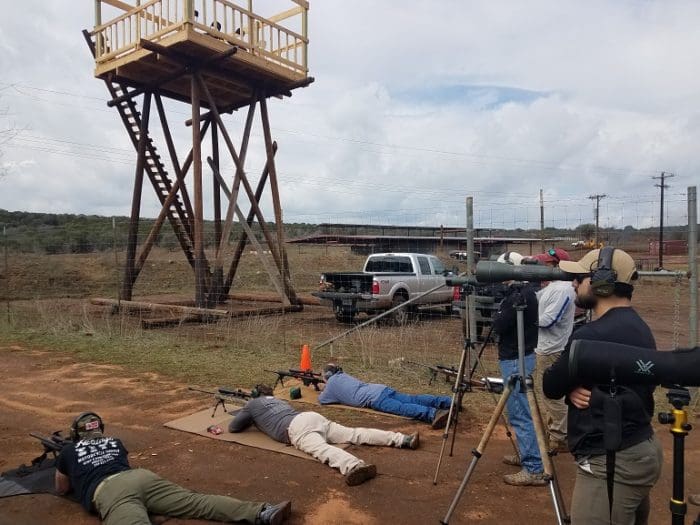
Clayton encouraged us to start thinking in Mils or MOA. If we were spotting, the goal was to relate corrections to the shooter not in inches or centimeters, but in MOA or Mils. It was here that I got to witness a level of ballistic virtuosity rarely seen. Clayton can switch back and forth to thinking in Mils or MOA.
Notice I said think, not calculate.
He’s not thinking in inches or centimeters and then doing the conversion when it comes to corrections, He’s thinking in MOA. He can do the same thing in Mils. That’s a pretty big shift in relative perception that only comes with a ton of experience.
Me, I definitely think in Mils. I grew up shooting a Mil Dot reticle on MOA turrets (why, dear Lord why were all the old scopes set up like that?). Between that, the military and medical, I still do most of my estimating and calculating using the metric system, so Mils just makes sense. Most folks in the US are more comfortable with MOA, as it better relates to the English Standard system of measurement. Either way, once you stop trying to do the conversion math every time, and just start forcing yourself to measure and think in Mils or MOA in the first place, you’ll find, as I did, calling corrections for yourself or your partner becomes much faster and less error prone.
We spent quite a bit of time on this exercise. It was a comprehensive skill test of everything we had learned that day. If you want, you can burn up a barrel on this course. If shooting a still target at farther distances than you have before is just tons of fun, you have the chance to keep hearing that distant ring over and over again. Like movers? Stay on it then. However, you also have the chance to validate what you’ve learned by a few reliable shots on target, and then move to something else. Clayton gave everyone the opportunity to try different targets, methods, positions, and roles at every stage of the shooting. But he didn’t push anyone. It was on you to get up and try something new.
The next morning we went back to the original firing line, around the 500 yard mark.
By this time, differences in the intrinsic accuracy, and comfort, of some of the stock hunting rifles were becoming apparent. One of the men in the course, and this particular course happened to be all men, was shooting a 700BDL in .30-06 with commercial hunting ammunition. After about 100 rounds, he was done. Not only did the stock not quite fit him, the recoil was just too much to bear. Clayton loaned him one of his personal rifles in .308, and he got to clanging steel with a quickness.
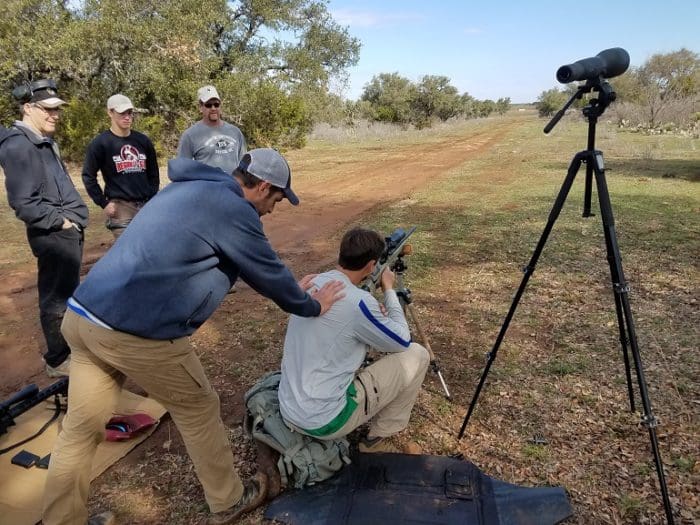
As I wasn’t there to focus on my prone game, I got up and asked to try some alternative positions almost immediately. Clayton got me sitting down while shooting off a backpack, and showing me how the fundamentals applied there, as well as some additional concepts.
After the class had shot for a while, we moved back a bit more, and Clayton went into a longer discussion and demonstration of those concepts and techniques. Just like in the prone, Clayton focused on keeping in line with the gun, regardless of position. He showed several new ways to improve stability by using body position, as well as objects to “fill the voids”. That concept, “filling the void”, was key. Essentially, any place where your body is unsupported, like a the gap between your thigh and the ground when you are standing, should be filled, if you can.
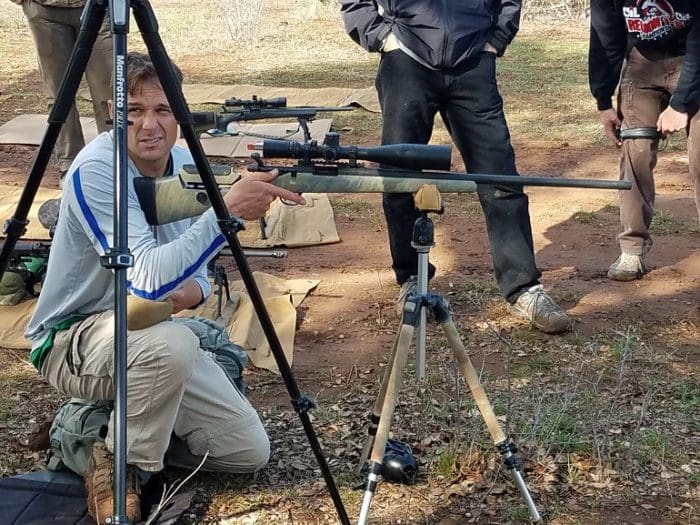
That concept led to some counterintuitive positions. For instance, from the kneel, I’ve always put my non-firing-hand leg forward. Clayton showed that dropping that leg, bringing my right up, and filling the space behind my knee and butt with a backpack makes a far more stable position than anything I could do with my left leg forward.
He also focused on using other object to stabilize the gun. For this example, he used both a nearby oak tree as well as a series of tripods. He same concepts applied, but with the additional technique of putting downward pressure on the rest, or on the rifle itself through the object. This could be done in few different ways, such as handing a bag from the tripod, or, in my case, wrapping my belt around the chassis of my rifle and pulling down hard on it in order to stabilize the gun on the tripod while standing.
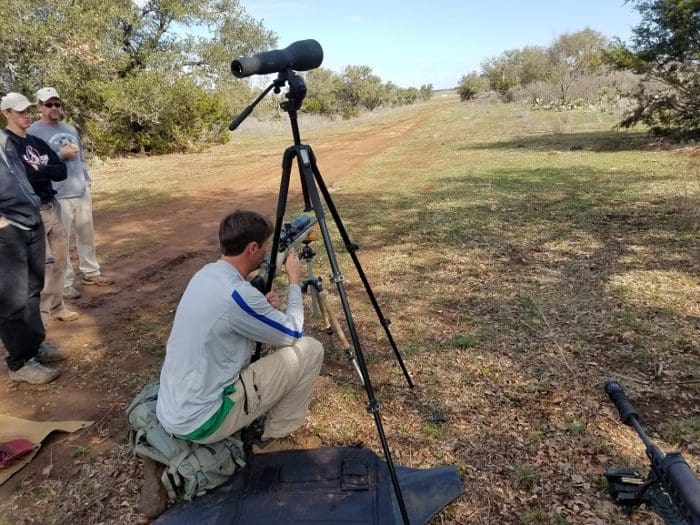
Note the use of the two tripods in this picture. The tall tripod is being used for convenience, it doesn’t have to be a tripod. It could just as well be a bush or a tree, while using your own tripod or bipod to actually shoot off of. Also take a look at how Clayton is using his bag for stabilization in this photo. Put altogether, this is absolute simple genius, and exactly what I wanted out of this course. I found the opportunity to use this exact position on a pig hunt this last weekend. Using the diagonal support beam of a fence, and a tripod, it got me high enough to get over the grass and south Texas scrub, but gave me just as much stability as I can get from the prone. Faraway pigs paid the ultimate price.
Of course, some of these position require quite a bit of time to set up right. Throughout the course, Clayton reminded the class that the best way to make the shot easier was just to move closer. If it’s going to take you 15 minutes to set up a shot to be sure of success, how much closer could you have moved in that time? If you are hunting over an area where you have scouted your prey before, is it possible to take your time and move to an angle that negates the wind? If so, spend that time, and take the easier shot.
We took a working lunch back in the classroom.
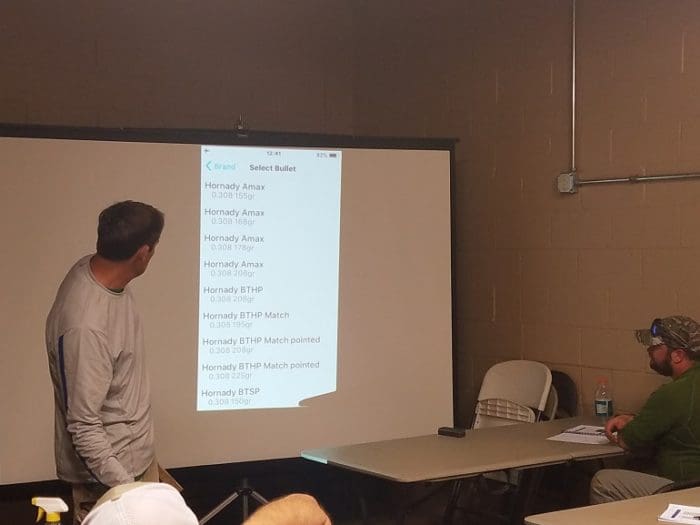
Just like Tyler’s original course, we also spent some time in the classroom going over ballistic software. Clayton teaches this as a whole course in and of itself, and it would be worth the time and money to attend. I’ve been using the same ballistic software for years, but Clayton showed me a few features on it I didn’t even know existed. His general knowledge on the subject is vast, and born of his own development of dynamic spreadsheets many years ago, before commercial software was readily available.
The end of the second day was back on the single line of targets, focusing on shooting farther and the moving targets. Again, if you wanted to stay in one position and try one thing over and over, that option was available to you. So was the opportunity to test everything you had learned so far by trying different targets in different position, as well as your role as a spotter.
Moving back to just past the 800 yard line, we had every opportunity to try everything we had learned. There were oak trees to shoot from, as well as the ability to set up bipods, backpacks, and tripods in multiple positions. Clayton encouraged everyone to focus on the smaller targets, as well as to try the movers at that range. We also got to work with the spotters calling out specific targets for the shooters to then locate and engage. This was especially challenging on the moving targets.
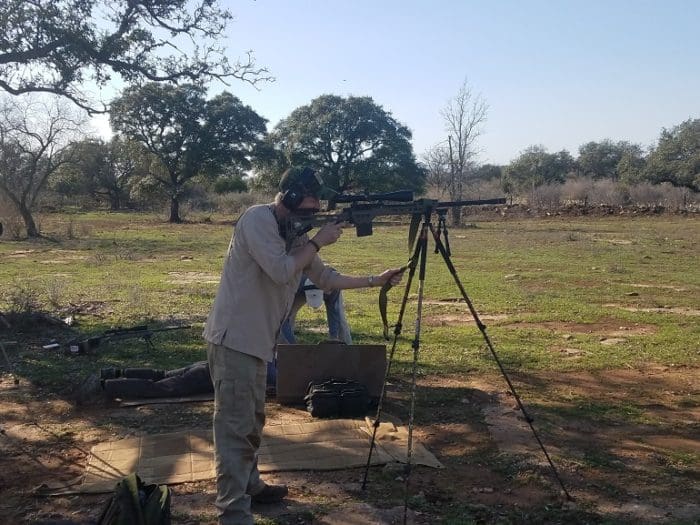
The culmination of my course was getting a first round hit on a 6″ plate at the 750 yard line while standing. I used a cheap Walmart Bog Pod that I couldn’t get stable enough to hit at 500 yards earlier in the day. Using the belt technique Clayton showed me earlier in the course, I was able to get the gun stable and achieve consistent hits. After that, seated shots off a rest on the 8″ target, well out to the 1,000 yard mark have seemed like far less of a challenge.
This course was designed for the beginner long range shooter, but because Clayton is so open and knowledgeable, it is well suited for the more experienced shooter as well. You just have to ask questions. I got exactly what I was looking for in the course, and I’d feel good about taking the whole thing over again.
ATX Precision Precision Rifle I
Two day course at Reveille Peak Ranch
Price: $625 (discounts available for groups and early registration)
Rating (out of five stars):
Overall * * * * *
The price of this course is commensurate with other courses of this topic and duration, but the quality of instruction is well beyond most instructors and most courses. When Clayton advertises this course as valuable for all skill levels, he ain’t kiddin. The course is relaxed, but with tons of opportunity to learn. I’d take the whole thing over again and be completely confident I’d get just as much out of it the next time. Outstanding course at a good price.





Good review. Jealous. How many rounds do you think you burned through, and can you bring multiple weapons?
250. But some people shot a lot more. Yes.
I’ve got the Whiskey shakes so bad I couldn’t hit a 16 inch target at 25 feet with a shotgun. And when I get drunk enuff to shoot straight I’m seeing double vision and stumbling in circles
Yeah that is a conundrum.
Never drank Conundrum, that must be Irish. ;~
Quitting drinking will be the most miserable month of your life.
In 6 months, you won’t believe how much better you will feel…
Just funnin, I don’t drink. But your right.
I’ve been wondering, where the hell was JWT? Turned to TTAG, and this GEM was first in line. Love long range shooting and this one, made my day. Excellent article and description of the class.
I got a lot of articles in the hopper, you’ll see them up for publication here in the next week or two.
I had a really great time there last year.
Things I still practice while remembering Clayton demonstrating.
I’ll even go through my class notes before a range session.
Good times.
Hey Tom–great to hear from you again! Thank you.
Thank you JWT–Glad to see it was a great value!
We have been cutting new shooting lanes in different spots on the ranch lately and working on some new classes. The new schedule will come out soon after the Spartan Race is over (it shuts down the ranges for almost 3 wks in May). It will include some single day clinics as well.
Also building out a one day PRS club match July 7th and a two day PRS Points match Sept 15/16. More shooting lanes in the works!
Thanks again!
–Clay
This course has my interest. But I have not been able to find where these courses are held anywhere on the web site. That would be really helpful information to determine if it’s within a reasonable traveling distance.
See the link I put to Tyler’s original review.
It’s just outside of Burnet, Texas.
Thought we lost you JWT..glad to see you back, n ow where’s Tyler?
Dittos – Now that there is a change in TTAG ownership, any chance Mr. Kee (and his fine pony) may return?
No idea, but I do miss the pictures of him in those Texas flag silkies. He’s a good dude.
sounds like a helluva class for a helluva good deal
“the gap between your thigh and the ground when you are standing” ??
Aren’t they perpendicular in that position ?
That is the first time I have seen “thigh gap” referenced in a precision rifle article.
Yes. On the non firing leg, fill the void.